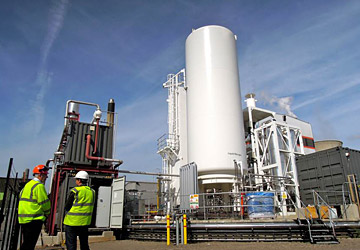Liquid Air – A Major Upcoming Technology?
Long established science may be the key to a renewable electricity grid
Compressing gases to liquids has been around for a long time. Liquid air powered cars were available in the early 1900s, but the technology was not mature enough and was superseded by petrol and diesel. Now it looks like liquid air, a versatile, non-polluting fuel, could become a significant method of storing renewable electricity, powering vehicles, reducing pollution, and increasing energy security for the UK, according to a new report released yesterday by the Centre for Low Carbon Futures. Professor Richard Williams, co-author of the report, says, “Solving Britain’s energy crisis requires better ways to store the power of the wind and the sun at large scale without relying on scarce natural resources, and liquid air provides a missing piece of that puzzle.”
Liquid air is simply ordinary air that has been compressed and chilled to around minus 200° C. Britain has a long tradition of compressing gases and the discussions at yesterday’s Royal Academy of Engineering Conference on liquid air and its application to energy and transport systems covered the practicalities of making this part of Britain’s energy system.
Liquid air could provide backup to the National Grid, smoothing out the variability of renewables. Where excess electricity is generated, it would be used to compress air in tanks, then when needed the air would be let out to power a turbine. The report estimates a single gasometer-style tank of liquid air could substitute for 5GW of power at peak times – around 10% of the UK’s peak electricity use. Having liquid air available would facilitate the projected increase of renewables on the grid. A network of liquid air tanks, compressed by using “surplus” electricity at night would be of huge benefit to the UK’s energy system. The fuel, is of course free, and completely non-polluting. This is projected to be an industry worth at least £1bn per year by 2050, and with the potential to create 22,000 jobs in the electricity industry alone.
Smaller systems could provide back-ups in organisations that need continuous power, including industry and hospitals, replacing polluting diesel generators. Waste heat from industrial processes could compress the air, then it would be ready for when it is needed.
Transportation is another area where liquid air could power vehicles, either partly or completely, as in the case of light city cars. You would fill up your tank with liquid air, in the same way (and a shorter time) that normally you would fill up with petrol or diesel. The report estimates production costs at 2.5-3.6p per litre of liquid air, or 4p a litre at the pumps. A massively lower cost than fossil fuels. Britain already has a surplus of 8500 tonnes per day of liquid nitrogen (the main component of liquid air), from industrial processes which is vented back into the atmosphere. If it was to be utilised as vehicle fuel, this would be equivalent to 6.5 million car kilometres daily.
Another use is in bigger vehicles, such as large trucks or buses, particularly those that have either refrigeration for goods or air-conditioning to keep passengers cool. Having an ancillary liquid air engine, powered by waste heat produced by the main vehicle engine, could provide the energy for the refrigeration system, or aircon, while the main engine was switched off, thus reducing emissions, noise nuisance, and lowering running costs.
Chief Engineer of Ricardo UK, Dr Andrew Atkins, outlined two new engines using liquid air or liquid nitrogen as fuel that the company are developing: a Dearman engine, originally invented by a classic British garden-shed boffin in the 1960s, and a “split cycle” high efficiency internal combustion engine which incorporates liquid nitrogen to capture exhaust heat and raise engine efficiency from the 40% of a normal diesel to around 60%, thus increasing mileage and reducing emissions.
All these developments are based around well-understood, proven technologies, that do not use any rare metals or unusual components. The fuel is around us all the time, and the exhaust is just air. To develop them and start implementing them on a significant scale will involve seed finance from public sources. When Vince Cable’s Green Investment Bank is fully functional this is the sort of project that it surely would want to finance? Britain is amongst the countries in the vanguard of this technology, and losing the developmental lead we have established would be another sad reminder of the decline of British research and industrial capabilities.
The obstacles remain finance and scalability. Creating a network of liquid air tanks attached to the National Grid is obviously the easiest way forward in the short term. Professor Williams says, “If we are to meet government targets by 2020 we are going to need large scale storage systems because of the intermittency of renewables.” He believes the technology is scalable and 4-5 liquid air plants attached to the grid would provide the backup needed with a grid powered by say 35% renewables. Manufacturing liquid air cars and having liquid air available at garages would be more problematical, although the report estimates that the capital costs of a Dearman-engine car would be equivalent to a conventional petrol one (and half that of an electric vehicle (EV) like the Nissan Leaf), with lower running costs than petrol or diesel, though they would be higher than EVs.
There are some hazards of safety – cryogenic liquids are dangerous because of their low temperature, but methods of storing them and preventing accidents are well understood and so there is no insuperable safety reason that they should not be widely used for both the grid and transportation.
The reduction in emissions possible by using liquid air is difficult to calculate because of its versatility. The report suggests that using liquid air to replace fossil fuel peak power generation and capturing excess wind energy or unused overnight electricity would save up to 8 million tonnes of CO2 annually. The amount of CO2 reduction for transportation is less clear, as there are no such vehicles on the market as yet, but it would be significant compared to conventional vehicles.
The energy security advantages include reducing gas imports by storing excess off-peak wind power to displace gas-fired peaking plant; reducing imports of oil, petrol and diesel by having vehicles using liquid air as their primary or auxiliary engine, reducing the risk of power cuts by storing liquid air till it was needed to feed into the grid; improving price security by having a backup available to avoid price spikes in other fuels.
Professor Williams says, “We have an opportunity, and growing need, to scale up our investment in technologies that will ensure the energy from renewables is not wasted, and the opportunities for the UK industrial sector are not lost. The Government is investing to give academic and business communities the chance to lead the world and develop new technologies and industries that can benefit the UK. Liquid air should be part of that effort; as the Centre for Low Carbon Futures report published today shows, it is a prime example of a technology that has the potential to deliver a more efficient energy system and bring the benefits of green growth to the UK.”
The report is available to download from:
Visit GreenJobs for the latest Low Carbon Jobs.




